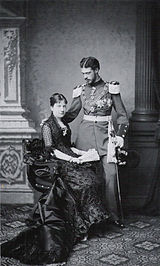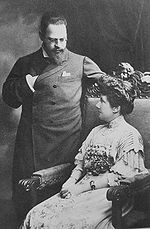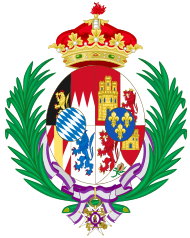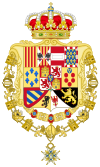Infanta María de la Paz of Spain
| Infanta María de la Paz of Spain | |||||
|---|---|---|---|---|---|
| Princess Ludwig Ferdinand of Bavaria | |||||
 | |||||
| Born | June 23, 1862 Madrid, Spain | ||||
| Died | December 4, 1946 (aged 84) Munich | ||||
| Spouse | Prince Ludwig Ferdinand of Bavaria | ||||
| Issue | Prince Ferdinand of Bavaria Prince Adalbert of Bavaria Princess Pilar of Bavaria | ||||
| |||||
| House | House of Bourbon | ||||
| Father | Francis of Assisi de Bourbon | ||||
| Mother | Isabella II of Spain | ||||
María de la Paz of Spain (María de la Paz de Borbón y Borbón) (Madrid, June 23, 1862 – Schloss Nymphenburg, Munich, December 4, 1946) was an infanta of Spain. A daughter of Queen Isabella II of Spain, she married her first cousin Prince Ludwig Ferdinand of Bavaria. She lived for the rest of her life in Germany, dedicating her time to her family, charity work and writing poetry. She wrote a book of memoirs:Through Four Revolutions: 1862-1933.
Childhood
Born at the Royal Palace of Madrid on June 23, 1862, Infanta Paz was the third surviving daughter of Queen Isabella II and her husband Francisco of Spain.[1] At age sixteen, Isabella II was forced to marry Francisco, Duke of Cádiz who was twice her first cousin. Isabella, who despised her effeminate husband, found an outlet for her passionate nature with a string of lovers. The relationship between King Francisco and his reputed children was cold and formal. Isabella II, preoccupied with her turbulent reign and her private life, alternated between periods of great affection towards her children and the distant approach to childhood that was the custom of the time.
According to historians, the biological father of Infanta Paz was the diplomat and politician Miguel Tenorio de Castilla (1818-1916), who was secretary of Queen Isabella II for several years.[2][3][4]
Infanta Paz probably also suspected that Tenorio de Castilla was her natural father. In 1890, in his old age, Tenorio de Castilla settled in a suite on the south wing of Schloss Nymphenburg, Paz’s residence. He lived there for twenty-six years until his death on December 11, 1916.[4] He bequeathed all his belongings to Infanta Paz, who accepted them as his universal heir.[4][5]
Infanta Paz was baptized by the archbishop of Toledo with the names María de la Paz Juana Amelia Adalberta Francisca de Paula Juana Bautista Isabel Francisca de Asis. Her godmother was her paternal aunt Infanta Amalia of Spain, Princess of Bavaria. In her first years, Infanta Paz was raised alongside her sisters Infantas Pilar and Eulalia in a wing of the Royal palace of Madrid. In the formal atmosphere of the Spanish court, the little infantas had little contact with their parents.[6]
Early life

In 1868, when she was only six years old, Paz and her family were forced to leave Spain by the revolution which cost Queen Isabella II her throne. The royal family was at that time in San Sebastian and on 30 September 1868, they crossed the border and went to live in exile in France. Isabella II settled in Paris with her children while King Francisco went to live separately in Épinay. Paz was educated with her sisters, Pilar and Eulalia, at the Sacré-Coeur, a Catholic school run by nuns. She received her first communion in Rome from Pope Pius IX.
In 1874 Paz’s brother King Alfonso XII was restored to the throne in place of their mother Queen Isabella II. Three years later, Paz returned to Spain with her sisters Pilar and Eulalia. She lived at first in El Escorial with her mother, but later moved to the Alcázar of Seville. When Isabella II returned to live permanently in Paris, Paz and her sisters moved to the Royal Palace of Madrid with their brother King Alfonso XII. The education and care of the three young infantas was placed under the supervision of their eldest sister Infanta Isabel. Paz was particularly close to her sister Pilar, who was only one year older. In 1879, Pilar, who was of delicate health, died suddenly while the sisters were in the small town of Escoriaza. Paz, who was seventeen at the time, was deeply affected by the death of her sister.
Of Queen Isabella’s five children to survive infancy, Paz was the one who resembled their mother most closely. Paz was short and plain with a small upward nose and a mischievous look in her small eyes. Unlike her sisters Isabel and Eulalia, Paz did not have a strong personality. She was uncomplicated, friendly and accommodating. Romantic and artistic, she was very fond of writing poems and was also a skillful painter. As a child, she studied the history of Spain, remaining interested in this subject. In later years she wrote articles published in the newspaper ABC. She was also musical; she played the harp, and enjoyed songs by Tosti as well as the operas of Verdi and Charles Gounod. She was also a devoted Catholic.
Marriage

By the spring of 1880, there were plans on the way to marry Infanta Paz to her first cousin Prince Ludwig Ferdinand of Bavaria.[7] Ludwig Ferdinand’s mother was Infanta Amalia of Spain, a sister of Paz’s father king Don Francisco, she was also a first cousin of Queen Isabella. Infanta Amalia wanted to marry her son to Infanta Paz, her goddaughter, and with this in mind, she wrote to her brother and her sister in law, who agreed with the project.[8]
Alfonso XII who had briefly studied in Munich with his cousin Prince Ludwig Ferdinand of Bavaria invited him to Madrid in order to meet Paz. On Sunday June 5 1880 Paz wrote on her diary: "Aunt Amalia of Bavaria (widow of Prince Adalbert) is in Paris with her sons Ludwig and Alphonso and her eldest daughter Isabella. Ludwig is eager to meet me, because he liked my portrait. My brother has invited them all to come to Madrid. The two brothers will arrive in the fall. I have heard many good things about Ludwig. They say he is serious and polite. He probably believes that I am better looking that I really am because of the portrait. I leave everything in God's hands ... "[9]
When in the fall of 1880 Infanta Paz finally met Ludwig Ferdinand, she found him unattractive and did not wish to marry him. Paz rebuffed the proposed marriage, but Ludwig Ferdinand did not abandon his intentions. After two years, lacking any other matrimonial prospect, Infanta Paz accepted her cousin's proposal. In January 1883, Ludwig Ferdinand returned to Spain to ask Paz in marriage. While walking together in the gardens of La casa de campo on January 22, 1883, he proposed and Paz accepted.[7] The marriage took place in the chapel of the royal Palace of Madrid on April 2, 1883. Paz retained her rights to the Spanish crown and received an annuity of 150,000 pesetas.[10] She was twenty years old. Among her gifts was the Bavarian sunburst tiara,[11] which remained in the princely family until it was sold at auction in 2013.[12]
Princess of Bavaria
On their way to Münich Paz and her husband stopped in Paris and visited King Francis who was living in retirement in Épinay.[7] In Bavaria the couple settled in Schloss Nymphenburg outside Münich. Prince Ludwig Ferdinand, was not only a cousin of King Ludwig II, but was well liked by him and he was in charge of some the King's financial affairs. In Munich, Paz met King Ludwig II of Bavaria, they conversed in French and he gave her a warm welcome.[13] A bangle given the Princess by Ludwig II was auctioned by Sotheby's in 2012.[14]
Their friendship was short lived. King Ludwig II was deposed and died under mysterious circumstances in 1886. He was succeeded by his only brother, Otto, who never truly ruled as King as he had been declared insane in 1875. Otto's uncle, Prince Luitpold of Bavaria, served as Prince Regent. During the festivities for her arrival at the Bavarian court Paz had met Prince Luitpold, who would be Regent of Bavaria until his death in 1912. Paz had already met in Spain two of Luitpold’s sons Arnolfo and Leopold. The second was married to Gisela, Archduchess of Austria, daughter of Emperor Francis Joseph and Paz and Gisela became good friends.[15] Paz was related to Luitpold's eldest son Ludwig who became King of Bavaria in 1913 as Ludwig III. His wife was half sister of Queen Maria Christina of Spain. Paz also had friends among members of the ducal branch of the house Wittelsbach.[15]
Paz' husband Prince Ludwig Ferdinand was a great music lover. He played the violin with the Munich royal orchestra.[16] Besides following a military career, reaching the highest ranks, he practiced medicine which he had studied at the University of Munich.[16] He avoided palace intrigues, for he did not like court life; the couple preferred to live quietly with their three children in Schloss Nymphenburg.[17] They surrounded themselves with Spanish artists visiting Bavaria: the composer Tomás Bretón, the violist Sarasate and the painters Rosales and Moreno Carbonero.
Children
The marriage of Infanta Paz and Prince Ludwig Ferdinand was long and happy. They had three children. The eldest, Prince Ferdinand, followed the tradition of Bavarian-Spanish marriages and lived for the rest of his life in Spain. Paz's youngest children inherited her artistic and literary interests. Prince Adalbert was a writer and historian; Princess Pilar was a painter and wrote a book about the reign of her cousin Alphonso XIII. Since her eldest son settled in Spain, Paz made frequent trips to her native country to visit her Spanish grandchildren:
- Infante Ferdinand of Spain, Prince of Bavaria (1884–1958); born in Madrid he settled permanently in Spain in 1905. He married his cousin Infanta Maria Teresa, daughter of Alfonso XII of Spain.
- Prince Adalbert of Bavaria (1886–1970). He was a historian and diplomat. He married Countess Augusta of Seefried and had two sons. They lived in Germany.
- Princess Pilar of Bavaria (1891–1987), unmarried. She worked as a painter.
Life in Bavaria

In Munich, Paz dedicated a great deal of her time to charity work.[18] She expanded an asylum for poor children, in Neuhausen near Nymphenburg, called Marien-Ludwig-Ferdinand. In 1913, she founded a school in Munich, within the grounds of Schloss Nymphenburg, that came to accommodate thirty-eight students who came from different provinces of Spain.[18] This institution was dissolved in 1918 with the revolution that ended the Bavarian monarchy. The Infanta was also in charge of the art exhibit held each year at the Munich Glaspalast until its destruction by fire in 1931.[18] Her house was visited by writers and artist such as Sarasate, Bretón, Richard Strauss, the painter Franz von Lenbach or the Nobel prize winner Paul Heyse among others.
From Bavaria Infanta Paz followed the life of her Spanish family through letters from her sister Isabel. Paz's only brother King Alphonso XII died young in 1886. Paz maintained a warm relationship with her sister in law Queen Maria Christina who was regent of Spain. Later King Alphonso XIII also had great affection for his aunt Paz. Paz's links to her native country were reinforced with the marriage of her eldest son Prince Ferdinand of Bavaria to his first cousin Infanta Maria Teresa. In 1905, her nephew Alphonso XIII visited Paz during his European tour in search of a wife. The following year Paz and her family went to Madrid and represented Bavaria in the wedding of King Alphonso XIII with Victoria Eugenia of Battenberg. As a wedding present Paz gave Victoria Eugenia a crown made of gold found in the river Darro, which had belonged to Isabella II.
In 1914 Infanta Paz made a journey by car to Salamanca, Leon, Oviedo, Covadonga and the Cantabrian coast, accompanied by the Marquis de la Vega de Anzo, her sister Infanta Isabel and her daughter Princess Pilar. At the outbreak of World War I in August that year she stayed in Nymphenburg. Her son, Adalbert, who was chief of artillery, joined the German forces. Her sister Eulalia was a frequent visitor and she was a great help after the devastation caused by World War I
Last years
After the war and the fall of the Bavarian monarchy, Infanta Paz and her family were allowed to keep on living in Nymphenburg. The family fortune was drastically reduced, but Paz still had income as a member of the Spanish Royal family. She made sporadic visits to Spain. While in Madrid they stayed at the royal Palace.[19] Paz also owned a rural property in Cuenca that she had inherited from her grandmother Queen Maria Cristina. She also owned the house of the Dukes of Riánsares, in Tarancón where she used to spend long sojourns enjoying the dry fields of la Mancha.[19] Nearby she bought a rural estate called Saelices, that her husband transformed into a model of agricultural farming. It was bought years later by the bullfighter Luis Miguel Dominguín. In October 1928 Paz went to the small town of Santillana del Mar, which she had visited previously in 1881, and the town council gave her a house to spend summers there.
Paz, whose name means "peace" in Spanish, honored her name in observance of pacifism. She took part in Pacifist congresses of 1921 in Paris, 1923 in Friburg, 1924 in London, 1926 in Luxembourg and 1926 in Bierville, France.[19]
Following the overthrow of her nephew Alphonso XIII in 1931, Paz lost her Spanish-derived income. Her life in Germany became more restricted with the arrival of Hitler to power in January 1933. Unlike the main branch of the Bavarian royal family, the Albertine branch - to which Paz' family belonged - were not outspokenly opposed to the Nazi regime. Paz' son Adalbert and his two sons Konstantine and Alexander served in the army during World War II until they were forced out when Hitler turned against the German princes. Gestapo officers checked her house; her letters with her Spanish correspondents were opened and read before they were sent on.
In 1945 American troops entered Munich. Some soldiers assaulted her house taking with them some jewelry that Paz had inherited from her mother which turned out to be fake.
In 1946 Paz accidentally fell down some stairs and died some hours later.[20] She was buried in the royal crypt in the church of San Michael in Munich. Her husband survived her by three years.
Author
Infanta Paz wrote the following books:
- Cuatro revoluciones e intemedios:Setenta años de mi vida. Memorias de la Infanta Paz. Espasa-Calpe, Madrid, 1935.[20] Published in English as Through Four Revolutions: 1862-1933.
- Aus meine Leben: Erinnereungen von Prinzessin Ludwig Ferdinand von Bayern (Munich, Georg Muller, 1917)[20]
- De mi vida. Impresiones (Madrid, 1909), De mi vida. Impresiones (Salamanca, 1911)
- Buscando las huellas de Don Quijote (Freiburg, 1905).[20]
- Emmanuela Theresa von Orden St. Clara, tochter des Kurfürsten Max Emanuel von Bayern 1696-1750 (Munich, 1902, published in German and in French ).[20]
- Poesías (Freiburg,1904), Roma eterna (Munich, 1922).[20]
She also translated from German to Spanish the historical books written by her son Prince Adalbert. Paz' personal diary was drawn upon by her son, who in taking some passages from it and adding extracts from her letters to members of her family, published a book with the title Through Four Revolutions: 1862-1933.
Arms
| Heraldry of María de la Paz of Spain | ||||||||
|---|---|---|---|---|---|---|---|---|
| ||||||||
Ancestry
Notes
- ^ Puga, 20 infantas de España, p. 133
- ^ Cierva, Alfonso y Victoria , p. 261
- ^ Vidal Sales, Francisco de Asís de Borbón y Borbón , p. 168
- ^ a b c Rey y Cabieses, Wittelsbach y Borbón, p. 15
- ^ Vidal Sales, Francisco de Asís de Borbón y Borbón , p. 169
- ^ Rey y Cabieses, Wittelsbach y Borbón, p. 16
- ^ a b c Rey y Cabieses, Wittelsbach y Borbón, p. 18
- ^ Rey y Cabieses, Wittelsbach y Borbón, p. 17
- ^ Infanta Paz, Cuatro revoluciones e intemedios , p. 88
- ^ Infanta Paz, Cuatro revoluciones e intemedios , p. 103
- ^ "The Bavarian Sunburst Tiara". A Tiara a Day.
- ^ "MAGNIFICENT JEWELS AND NOBLE JEWELS". Sothebys.
- ^ Rey y Cabieses, Wittelsbach y Borbón, p. 20
- ^ "Magnificent jewels and noble jewels".
- ^ a b Rey y Cabieses, Wittelsbach y Borbón, p. 21
- ^ a b Rey y Cabieses, Wittelsbach y Borbón, p. 24
- ^ Rey y Cabieses, Wittelsbach y Borbón, p. 25
- ^ a b c Rey y Cabieses, Wittelsbach y Borbón, p. 22
- ^ a b c Rey y Cabieses, Wittelsbach y Borbón, p. 28 Cite error: The named reference "Rey y Cabieses 28" was defined multiple times with different content (see the help page).
- ^ a b c d e f Rey y Cabieses, Wittelsbach y Borbón, p. 29
Bibliography
- Aronson, Theo. Venganza real: la Corona de España, 1829-1965. Ed.Grijalbo, 1968.
- Infanta Paz; Cuatro revoluciones e intemedios: Setenta años de mi vida. Espasa-Calpe, Madrid, 1935.
- Infanta Eulalia; Memorias de Doña Eulalia de Borbón, Infanta de España (1864-1931). Ed. Juventud, 1954.
- Baviera, S.A.R. Princesa Pilar de; Chapman-Huston, Comandante Desmond. Alfonso XIII. Col. "Z"
- Puga, Maria Teresa; 20 infantas de España: Sus vidas, entre las ilusiones y el destino. Ed. Juventud, Barcelona, 1998.
- Rey y Cabieses, Amadeo-Martín, Wittelsbach y Borbón: Relaciones y Enlaces Entre las Casas Reales de Baviera y de España, Siglos XIX Al XXI, Consejo Superior de Investigaciones Científicas, 2005
- Vidal Sales, José Antonio; Francisco de Asís de Borbón y Borbón: la peripecia íntima, secreta y sentimental del esposo de Isabel II, un rey consorte afeminado y blando. Ed. Planeta, 1995



